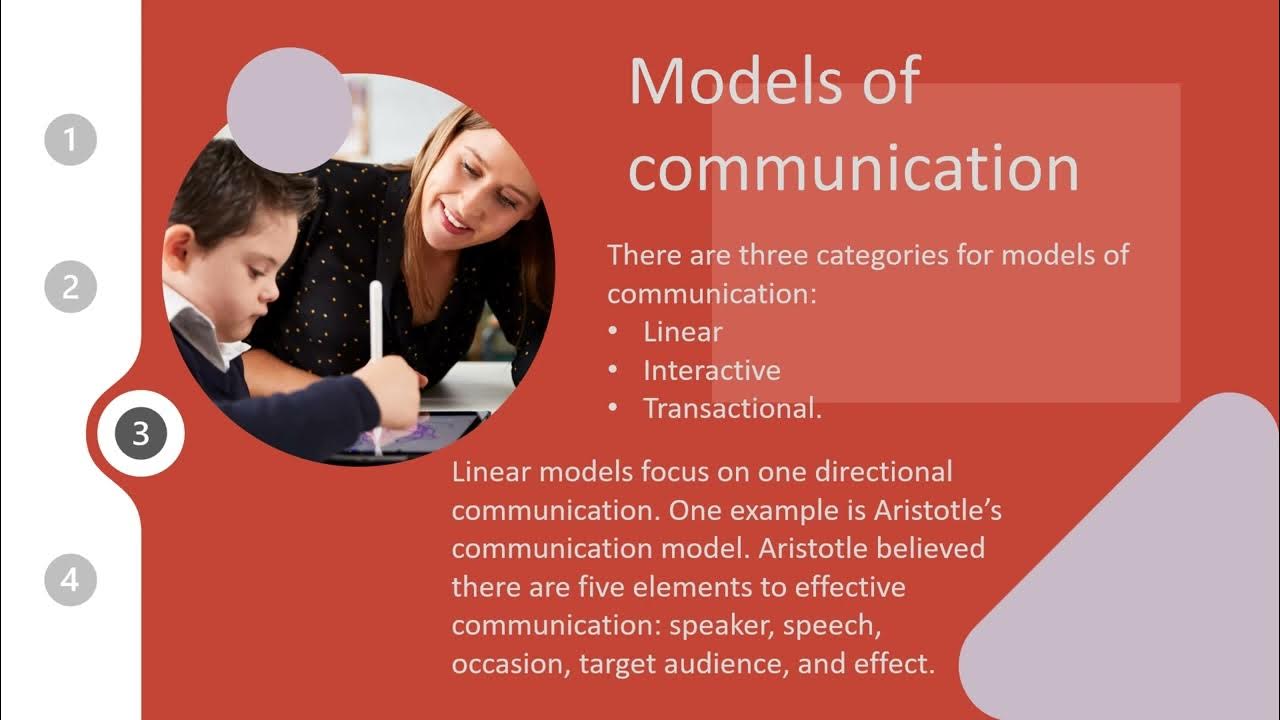Communication Types of Models, Principles & Misconceptions
Summary
TLDRThis script explores three fundamental models of communication: linear, interactive, and transactional. It emphasizes the importance of feedback in the interactive model and simultaneous message exchange in the transactional model. The script debunks common misconceptions, such as the belief that communication is solely verbal or that it always resolves issues. It highlights five key principles of communication, including its intentional or unintentional nature, irreversibility, and contextual influence, while stressing the need for continuous improvement in communication skills.
Takeaways
- 🔁 The linear model views communication as one-way, from sender to receiver without feedback.
- 🔄 The interactive model sees communication as two-way, including a feedback loop and considering noise and context.
- 🤝 The transactional model perceives communication as simultaneous, where participants are both senders and receivers.
- 💬 Communication can be both intentional and unintentional, emphasizing that nonverbal cues also convey messages.
- ⏳ Communication is irreversible; once a message is sent, it cannot be taken back, similar to opening Pandora's box.
- 📽 Each communication event is unique and unrepeatable, influenced by the context and environment.
- 🌐 Communication is contextual, governed by the rules and norms of different cultures and situations.
- 🗣️ Meaning is not solely in words; nonverbal communication and relationship dynamics also play a crucial role.
- 🚫 More communication is not always better; sometimes, less is more, and silence can be a powerful tool.
- 🤔 Communication is not a simple process; it is complex and can sometimes lead to misunderstandings or conflicts.
Q & A
What are the three basic models of communication discussed in the script?
-The three basic models discussed are the linear model, the interactive model, and the transactional model.
How does the linear model of communication view the communication process?
-The linear model views communication as a one-way process where a message is encoded by the source, sent through a channel, and decoded by the receiver without feedback.
What is the main difference between the interactive and linear models?
-The interactive model includes a feedback loop, accounting for two-way communication, whereas the linear model does not include feedback.
What does the term 'behaves' in the interactive model of communication signify?
-The term 'behaves' signifies that communication can be both intentional and unintentional, allowing for a broader understanding of how messages are conveyed.
How does the transactional model differ from the other two models?
-The transactional model views communication as occurring simultaneously, where participants are both senders and receivers at the same time, creating a relationship through the exchange of messages.
What is the revised definition of communication according to the transactional model?
-Communication is defined as a continuous, transactional process involving participants operating within specific contexts, creating a relationship by simultaneously sending and receiving messages via channels, often distorted by noise.
What are the five principles of communication mentioned in the script?
-The five principles are: communication can be intentional or unintentional, it is inescapable, it is irreversible, it is unrepeatable, and it is contextual.
Why is it said that communication is inescapable?
-Communication is inescapable because even the act of not responding to a message is a form of communication in itself, conveying a certain stance or attitude.
What misconception about communication is the idea that 'more is better'?
-The misconception that 'more is better' suggests that increased communication always leads to better outcomes, which is not true as sometimes less communication or carefully chosen words are more effective.
Why is the idea that communication will solve all problems considered a myth?
-This is a myth because while communication is crucial, it is not a panacea. There are times when understanding each other perfectly still does not prevent disagreement or conflict.
What does the script suggest about the ability to communicate effectively?
-The script suggests that effective communication is not an innate ability but a skill that can be improved upon through understanding and practice.
What is the role of context in communication according to the script?
-Context plays a significant role in communication as it governs the rules and norms within which communication occurs, affecting how messages are interpreted and responded to.
Outlines

このセクションは有料ユーザー限定です。 アクセスするには、アップグレードをお願いします。
今すぐアップグレードMindmap

このセクションは有料ユーザー限定です。 アクセスするには、アップグレードをお願いします。
今すぐアップグレードKeywords

このセクションは有料ユーザー限定です。 アクセスするには、アップグレードをお願いします。
今すぐアップグレードHighlights

このセクションは有料ユーザー限定です。 アクセスするには、アップグレードをお願いします。
今すぐアップグレードTranscripts

このセクションは有料ユーザー限定です。 アクセスするには、アップグレードをお願いします。
今すぐアップグレード5.0 / 5 (0 votes)






